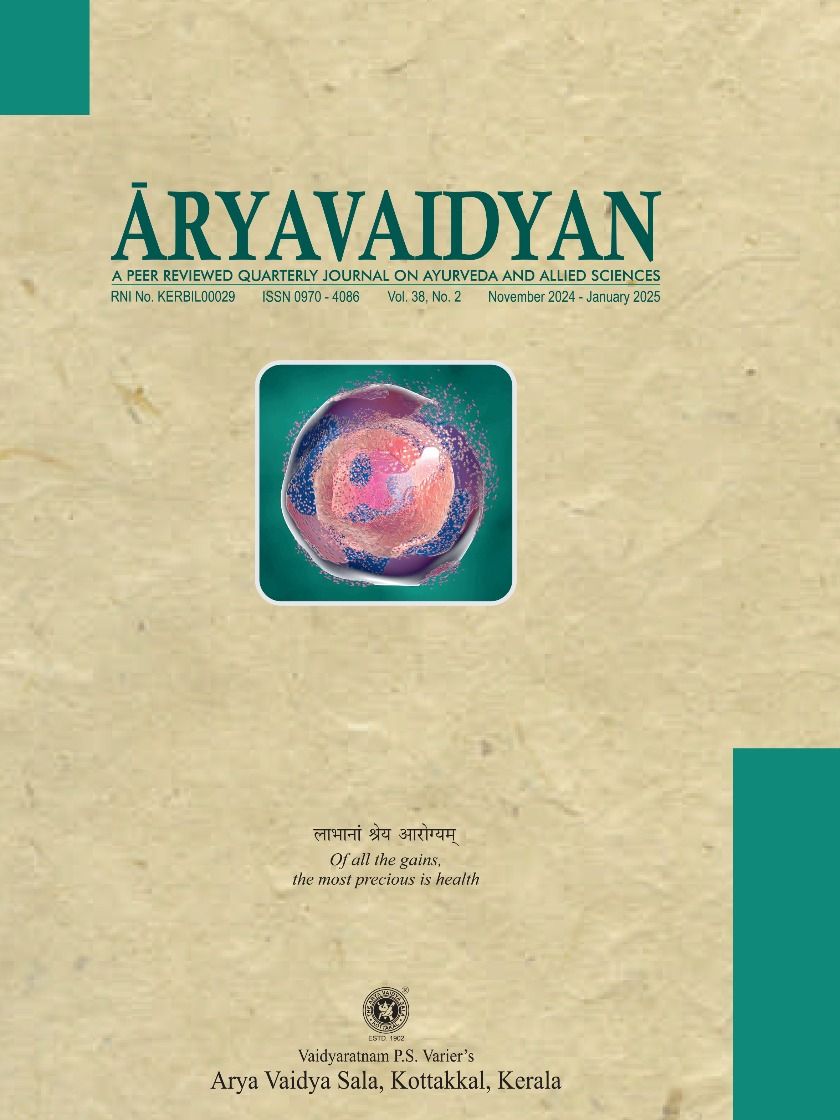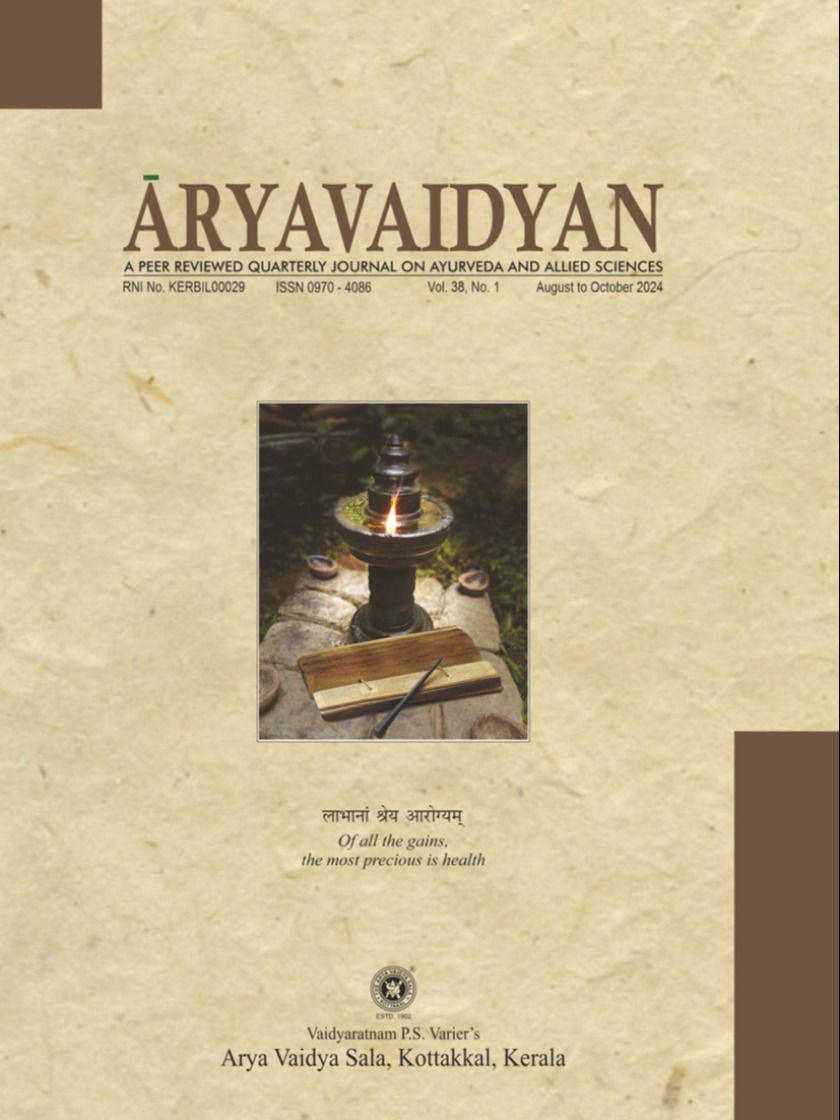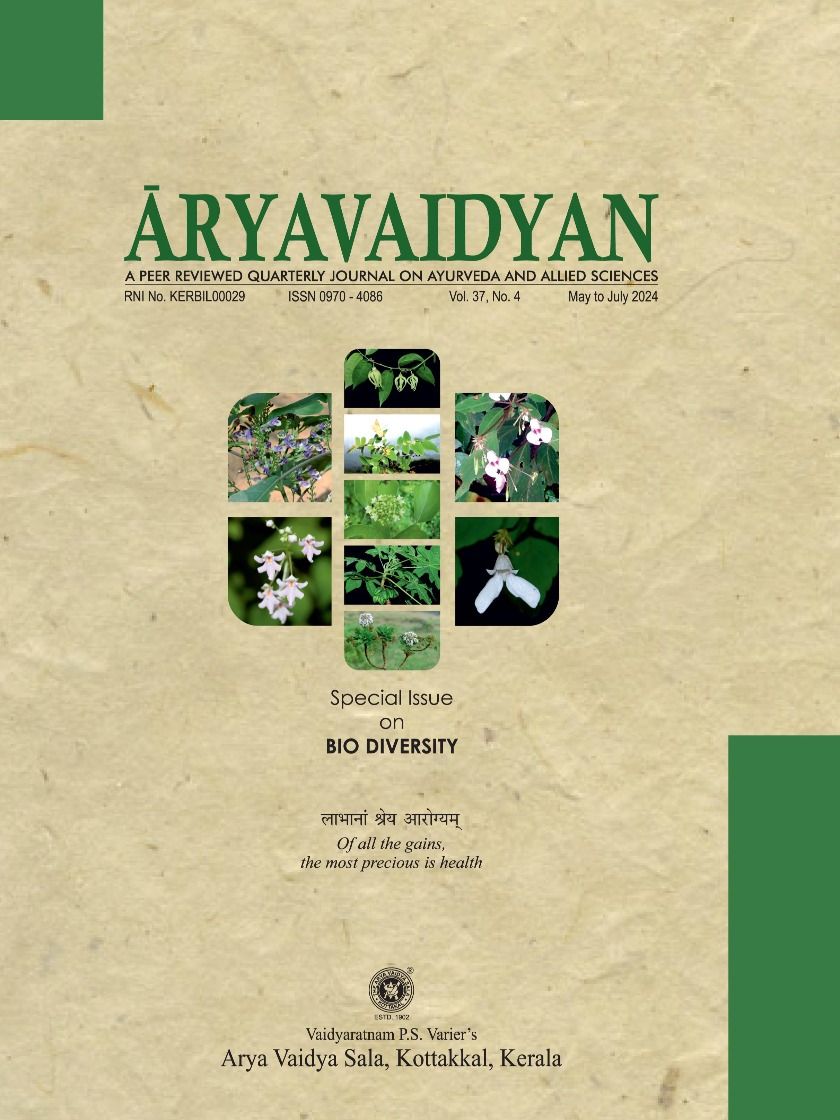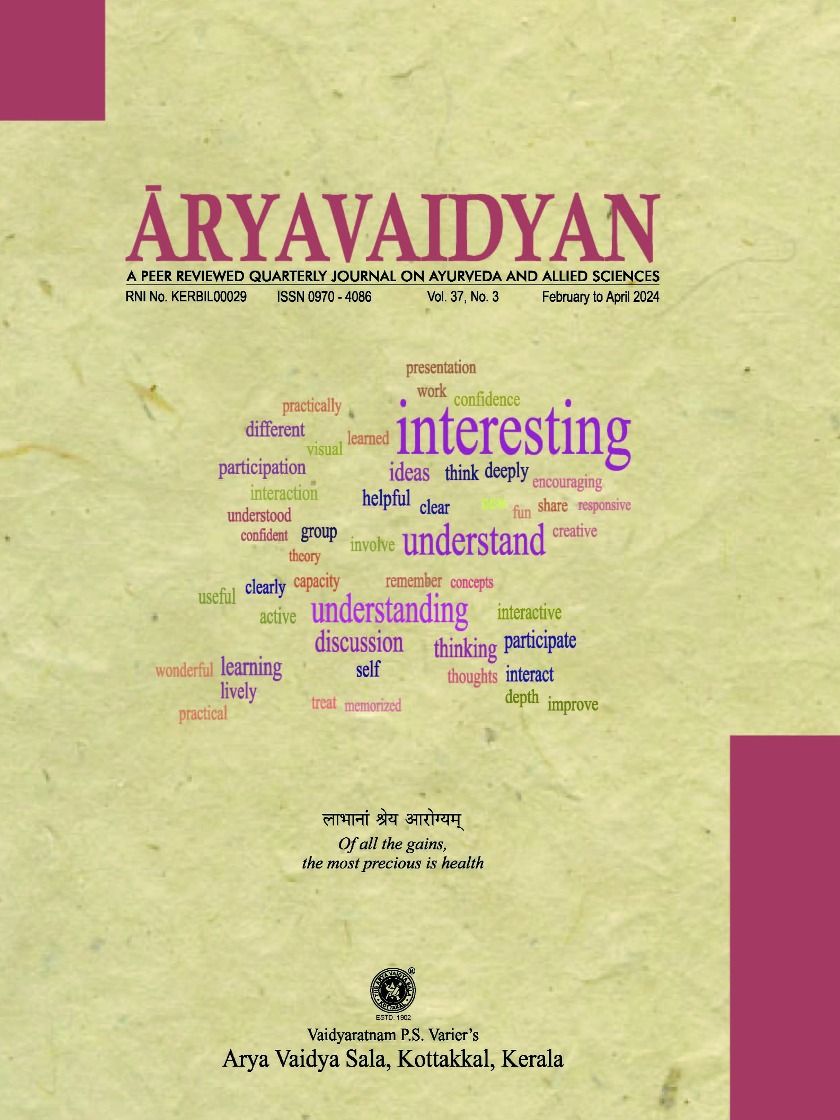
Contents
- Vishnu P
- Kayacikitsa
- Aug 28, 2024
ROLE OF IMMUNOSENESCENCE AND INFLAMMAGING IN LIFE STYLE DIEASES
- Shailza Bhatnagar
- Ayurveda Literary Studies
- Jul 02, 2024
Scientific review of Madhumehari Churna: An Ayurvedic polyherbal formulation used in management of Diabetes Mellitus
- Deepthy Susan Tharacheril
- Salyatantra
- Aug 24, 2024
Ayurvedic Conservative Management in a Metastatic Prostate Carcinoma Patient Undergoing Palliative Hormone Therapy- A Case Report
- Sreelakshmi P R
- Dravyagunavijnana (Agriculture)
- Oct 30, 2024
From Waste to Wealth: Diverse Preparation Methods for Kuṉapajala – A Review
- KARTHIKA KANNANMURI JAYAN
- Pancakarma
- Jul 07, 2024
RESPONSE OF PREGNANCY INDUCED BILATERAL CARPEL TUNNEL SYNDROME TO AYURVEDIC MANAGEMENT: A CASE STUDY.
- Pooja BA
- Pancakarma
- Oct 08, 2024
Management of Frozen to Thawing stage of frozen shoulder w.s.r to Apabahuka - a case report
- Eswara Sharma M P
- Book Review
- Feb 17, 2025
Alathoor Manipravalam - A review
- Rati Vijayan
- Pages from Dhanvantari
- Feb 17, 2025
Marriage (Vivaham)
Editorial
Ayurveda Education: Honouring Local Knowledge and Experiential Learning
Prof. Narayanan Nambi
Principal
Ashtangam Ayurveda Vidyapeeth
Vavannur, Pattambi,Kerala
Ayurveda, with its origins in the ancient Indian subcontinent, represents a profound system of health and well-being. As it developed over thousands of years, it drew heavily from the natural environment, local herbs and traditional knowledge specific to each region. Institutionalized teaching of ayurveda began only about 150 years ago, and since then, the system has adapted to fit the frameworks of formal education. However, this shift has brought challenges. While structured educational frameworks are beneficial, there is a need to preserve the core of ayurveda by emphasizing local herbs, traditional practices and experiential learning to foster a truly holistic understanding among students.
Four pillars can be considered supporting ayurvedic education are- Principles, Texts, Applications and Experiences.
Principles(Tatwa)
Ayurveda’s guiding principles, or tatwa, are universal and timeless. Concepts such as the tridosha theory, which explains health in terms of balancing vaata, pitta and kapha, provide a framework that can be applied across different cultures and times. However, while these principles are universal, the interpretation and application of ayurveda rely heavily on understanding local contexts and resources.
Texts(Saastra)
Texts, or Saastra, have always been foundational to ayurveda. These texts, however, are not static. Ayurveda has evolved through centuries, with regional variations of its teachings, practices and medicinal texts. The ancient sages adapted ayurvedic texts to suit the needs of their regions, writing about locally available herbs, seasonal changes and cultural nuances. Modern education must respect this tradition of adaptation, recognizing that a one-size-fits-all approach does not do justice to ayurveda’s diverse legacy.
Applications(Vyavahaara)
Applications of ayurveda, or vyavahaara, are highly personalized and context-dependent. Traditional ayurveda did not operate with rigid, standardized protocols; instead, it allowed practitioners to adapt treatments based on their personal insights, patient needs and available resources. This personalization is vital to ayurveda’s effectiveness, and it highlights the importance of giving students practical exposure to a range of applications within local contexts.
Experiences(Anubhava)
Anubhava, or experiential knowledge, is deeply valued in ayurveda. Personal experience is essential in developing a nuanced understanding of this medical system. Every practitioner’s journey is unique, shaped by their interactions with patients, their hands-on learning, and their reflections on the principles and texts. If ayurveda education sidelines the role of personal experiences, it risks becoming rigid and losing its true essence as a holistic, experiential science.
The need to impart regional practices and knowledge
One of ayurveda’s greatest strengths lies in its close connection with nature and local environments. Each region’s flora, fauna, climate and cultural practices uniquely shape the practice of ayurveda in that area. For students to become proficient in ayurveda, they must learn not just about universally known herbs but also about local plants, their properties and traditional uses. Educational content should go beyond standard texts to include regional medicinal plants and their applications, helping students understand the richness of their local resources.
Ignoring local knowledge for the sake of global standardization dilutes ayurveda’s true potential. When ayurveda education focuses solely on standardized protocols and overlooks the wealth of local herbs and practices, it risks losing a fundamental part of what makes it effective and adaptable. Students should be encouraged to learn about locally available resources, recognize their medicinal properties and understand how to apply them in context. This approach allows ayurveda to maintain its connection to nature and regional heritage, ensuring that future practitioners can adapt their knowledge to their surroundings.
Moving Beyond Structured Frameworks: The Importance of Philosophy and Spirituality
Modern educational frameworks, such as Bloom’s Taxonomy and Miller’s Pyramid, provide structure and help set learning outcomes, but ayurveda education must go deeper. Ayurveda is not just a science of the body; it is a science of life that encompasses mind, body, and spirit. Incorporating teachings on philosophy and spirituality is essential to conveying Ayurveda’s full scope. By understanding philosophical foundations and concepts like praana (life force) and agni (digestive fire), students develop a holistic perspective that goes beyond technical skills.
Spirituality and self-awareness, which are deeply embedded in ayurveda, encourage practitioners to look within and approach healing with empathy and insight. Educators should therefore integrate teachings on other philosophical systems, such as Yoga, Samkhya, and Vaisheshika, that enhance students’ understanding of health, consciousness and well-being. This expanded education enables students to connect ayurvedic principles to a larger worldview, nurturing practitioners who are both knowledgeable and compassionate.
The Value of Hands-On Experience and Personal Reflection in Learning
One of the defining characteristics of ayurveda is its emphasis on experiential learning—a process that involves not only understanding concepts but also actively applying them in real-world settings. For students, this means that true mastery of ayurveda cannot come from textbooks alone; it requires hands-on engagement with patients, herbs, therapies and the natural world. Practical experience allows students to internalize the principles of ayurveda and develop an intuitive understanding that complements theoretical knowledge.
In ayurveda, learning by doing is as important as learning by reading. Working directly with patients enables students to observe the unique ways in which individuals respond to treatments, highlighting the importance of personalized care. Each case becomes an opportunity to explore and interpret ayurveda's principles in action, helping students build confidence and skill. This practical engagement reinforces the idea that no two patients are exactly alike, encouraging a flexible and adaptive approach to treatment.
Furthermore, the experiential aspect of ayurveda education should include the hands-on identification and preparation of medicinal plants. By touching, smelling and processing herbs, students gain a deeper appreciation for these natural resources and learn to recognize subtle variations that may not be captured in theoretical descriptions. This direct interaction with nature fosters a connection to the plant world, helping students understand the medicinal qualities of local herbs that are integral to traditional ayurvedic practices.
Reflection is equally vital in this process. Ayurveda emphasizes not only what a student has done but also what they have understood, imagined and experienced through their actions. Encouraging students to reflect on their clinical encounters, herbal preparations and personal observations allows them to cultivate insight and critical thinking. Reflection bridges the gap between theory and practice, helping students articulate what they’ve learned and develop their own interpretations and philosophies within ayurveda. This introspection is a powerful tool for growth, as it allows students to assess their strengths, confront their limitations and refine their approach for healing.
Ultimately, hands-on experience and personal reflection in ayurveda education nurture a deep-rooted, holistic understanding of health and healing. By encouraging students to learn through direct experience and introspective practice, ayurveda education preserves the system’s richness and ensures that future practitioners carry forward its values of empathy insight, and adaptability.
In nutshell, ayurveda education, while benefiting from modern educational frameworks, must honor its roots in local knowledge, traditional practices and experiential learning. The core principles of ayurveda—tatwa (universal principles), saastra (texts), vyavahaara (applications) and anubhava (experiences)—emphasize the importance of context and personal insight. As ayurveda evolves in institutional settings, it is crucial to integrate local herbs, regional practices and individualized patient care into the curriculum. Structured education is valuable, but it should not overshadow the system’s inherent flexibility and emphasis on personalized treatment. By fostering hands-on experience, reflection and philosophical understanding, ayurveda education can preserve its holistic approach while preparing future practitioners to connect deeply with both the science and the spirit of healing.
Editorial Board
Chief Editor
Prof. K. Murali
Former Professor, Govt. Ayurveda College, Thrippunithura, Kerala
Sub Editors
Dr. A. Raghunathan Nambisan
Executive Editor
Dr. Devikrishnan K.
Chief Sub Editor
Dr.Sulaiman C T
Associate Editor
Advisory Board
Dr Madan Thangavelu
Genome Biologist, University of Cambridge, United Kingdom
Dr Lakshmi Pulakkat
Molecular Cardiology Research Institute (MCRI) ; Professor of Medicine, Tufts University School of Medicine; Adjunct Professor of Medicine, University of Missouri-Columbia School of Medicine
Dr. P. Madhavankutty Varier
Patron
Dr. Naveen Kumar V.V.
Plant Taxonomist, Centre for Environment & Marine Studies, King fahd University of Petroleum & Minerals, Saudi Arabia
Dr. Sunil Kumar Vijaya Gopal,
Senior Research Associate, Lutheran Hospital, Germany
Dr. T. Sreekumar
Emeritus Professor, PNNM Ayurveda College, Cheruthuruthy, Thrissur
Dr. M. Prasad
Director, Sunethri Ayurvedashram & Research Centre, Trikkoor, Thrissur
Dr. J.S.R. Prasad
Professor, University of Hyderabad
Dr. M.V. Vinod Kumar
Professor, VPSV Ayurveda College, Kottakkal
Dr. K. Muraleedharan
Trustee & Additional Chief Physician, Arya Vaidya Sala, Kottakkal
Dr. P. Ramkumar
Trustee & Factory Manager, Arya Vaidya Sala, Kottakkal
Shri Ajay K.R.
Trustee & Factory Manager, Arya Vaidya Sala Factory, Nanjangud
Shri P. Rajendran
Joint General Manager (Corporate Affairs), Arya Vaidya Sala, Kottakkal
Shri K.V. Ramachandran
Consultant, Arya Vaidya Sala, Kottakkal
Dr. Indira Balachandran
Project Director, Centre for Medicinal Plants Research, Arya Vaidya Sala, Kottakkal
Dr. Leena Abraham
Former Professor, Tata Institute of Social Science, Mumbai
Dr. Tanuja Nesari
Director, All India Institute of Ayurveda, New Delhi
Dr. Santhosh S.R. Nair
Chaudhary Brahm Praksh Ayurveda Charak Sansthan, New Delhi
Dr. M.V. Anilkumar
Professor, School of Fundamental Research in Ayurveda, Tripunithura
Dr. Narayanan Nambi
Principal, Ashtangam Ayurveda Vidyapeetham, Vavanoor, Koottanad, Palakkad District, Kerala



